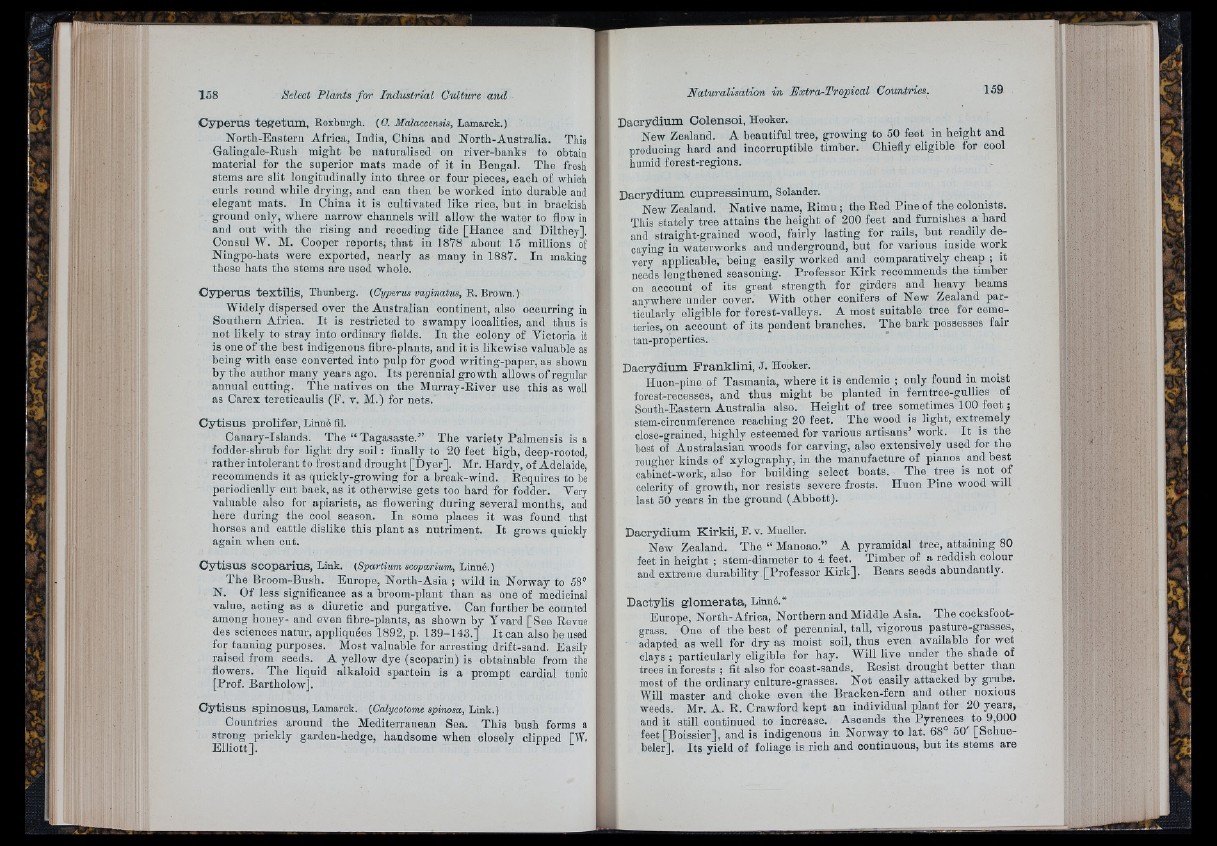
C y p e ru s te g e tum , Roxburgh. (O. Malaccensis, Lamarck.)
North-Eastern Africa, India, China and North-Australia. This
Galingale-Rush might be naturalised on river-banks to obtain
material for the superior mats made of it iu Bengal. The fresh
stems are slit longitudinally into three or four pieces, each of which
curls round while drying, and can then be worked into durable and
elegant mats. In China it is cultivated like rice, but in brackish
ground only, where narrow channels will allow the water to flow in
and out with the rising and receding tide [Hance and Dilthey],
Consul W. M. Cooper reports, th a t in 1878 about 15 millions of
Ningpo-hats were exported, nearly as many in 1887. In making
these hats the stems are used whole.
C y p e ru s te x tilis , Thunberg. (Gyperus vaginatus, R. Brown.)
Widely dispersed over the Australian continent, also occurring in
Southern Africa. I t is restricted to swampy localities, and thus is
not likely to stray into ordinary fields. In the colony of Victoria it
is one of the best indigenous fibre-plauts, and it is likewise valuable as
being with ease converted into pulp for good writing-paper, as shown
by the author many years ago. Its perennial growth allows of regular
annual cutting. The natives on the Murray-River use this as well
as Carex tereticaulis (F. v. M.) for nets.
C y tis u s p ro life r, Linné fil.
Canary-Islands. The “ Tagasaste.” The variety Palmensis is a
fodder-shrub for light dry soil : finally to 20 feet high, deep-rooted,
rather intolerant to frost and drought [Dyer]. Mr. Hardy, of Adelaide,
recommends it as quickly-growing for a break-wind. Requires to be
periodically out back, as it otherwise gets too hard for fodder. Very
valuable also for apiarists, as flowering during several months, and
here during the cool season. In some places it was found that
horses aud cattle dislike this plant as nutriment. I t grows quickly
again when cut.
C y tis u s so o p a riu s , Link. {Spartium scoparium, Linné.)
The Broom-Bush. Europe, North-Asia ; wild in Norway to 58°
N. Of less significance as a broom-plant than as one of medicinal
value, acting as a diuretic and purgative. Can further be counted
among honey- and even fibre-plants, as shown by Yvard [See Revue
des sciences natur, appliquées 1892, p. 139-143.] I t can also be used
for tanning purposes. Most valuable for arresting drift-sand. Easily
raised from seeds. A yellow dye (scoparin) is obtainable from the
flowers. The liquid alkaloid spartein is a prompt cardial tonic
[Prof. Bartholow .
C y tis u s sp in o su s , Lamarck. (Galycotome spinosa, Link.)
Countries around the Mediterranean Sea. This bush forms a
strong prickly garden-hedge, handsome when closely clipped [W.
Elfiott].
D a c ry d ium C o len so i, Hooker.
New Zealand. A beautiful tree, growing to SO feet^ in height and
producing hard and incorruptible timber. Chiefly eligible for cool
humid forest-regions.
D a c ry d ium c u p re s s in um , Solander.
New Zealand. Native name, Eimu ; the Red Pine of the colonists.
This stately tree attains the height of 200 feet and furnishes a hard
and straight-grained wood, fairly lasting for rails, hut _ readily decaying
in waterworks and underground, but for various inside work
very applicable, being easily worked and comparatively cheap ; it
needs lengthened seasoning. Professor Kirk recommends the timber
on account of its great strength for girders and heavy beams
anywhere under cover. With other conifers of New Zealand partioularly
eligible for forest-valleys. A most suitable tree for cemeteries,
on account of its pendent branches. The bark possesses fair
tan-properties.
D a c ry d ium P r a n k lin i, J. Hooker.
Huon-pine of Tasmania, where it is endemic ; only found in moist
forest-recesses, and thus might be planted in ferntree-gullies of
South-Eastern Australia also. Height of tree sometimes 100 feet ;
stem-circumference reaching 20 feet. The wood is light, extremely
close-grained, highly esteemed for various artisans’ work. I t is the
best of Australasian woods for carving, also extensively used for the
rougher kinds of xylography, in the manufacture of pianos and best
cabinet-work, also for building select boats. The tree is not of
celerity of growth, nor resists severe frosts. Huon Pine wood will
last 50 years in the ground (Abbott).
D a c ry d ium Kirisii, F. v. Mueller.
New Zealand. The “ Manoao.” A pyramidal tree, attaining 80
feet in height ; stem-diameter to 4 feet. Timber of a reddish colour
and extreme durability [Professor K irk ]. Bears seeds abundantly.
Dactylis g lom e ra ta , Linné.*
Europe, North-Africa, Northern and Middle Asia. The cooksfoot-
grass. One of the best of perennial, tall, vigorous pasture-grasses,
adapted as well for dry as moist soil, thus even available for wet
clays ; particularly eligible for hay. Will live under the shade of
trees in forests ; fit also for coast-sands. Resist drought better than
most of the ordinary culture-grasses. Not easily attacked by grubs.
Will master and choke even the Bracken-fern and other noxious
weeds. Mr. A. R. Crawford kept an individual plant for 20 years,
and it still continued to increase. Ascends the Pyrenees ^ to 9,000
feet [Boissier], and is indigenous in Norway to lat. 68° 60 [Schuebeler].
Its yield of foliage is rich and continuous, but its stems are